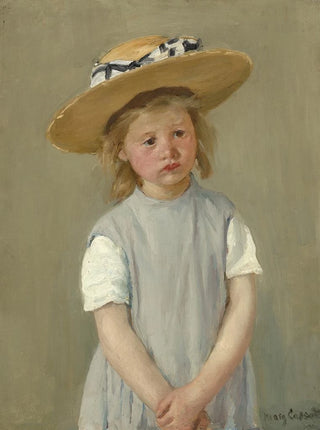Art print | L'enfant au chapeau de paille - Mary Cassatt


View from behind

Frame (optional)
In the fascinating world of impressionist art, "L'enfant au chapeau de paille" by Mary Cassatt emerges as an iconic work, revealing the delicacy and emotional power that characterize this American artist's oeuvre. Painted at the end of the 19th century, this canvas not only illustrates Cassatt's genius but also her commitment to representing women and children, a central theme of her work. The scene, imbued with tenderness, invites us to immerse ourselves in a moment of complicity between a mother and her child, capturing an essence of everyday life with unmatched finesse. The soft light bathing the painting, along with pastel colors, creates a warm and serene atmosphere, where the viewer's gaze is immediately drawn to the expressive face of the child.
Style and uniqueness of the work
Mary Cassatt's style is distinguished by her unique approach to light and color, as well as her ability to capture the intimacy of human relationships. In "L'enfant au chapeau de paille," she uses fluid and light brushstrokes, giving the artwork an almost ethereal quality. The details of the straw hat, with its golden nuances, contrast with the softer tones of the child's face, creating a visual balance that catches the eye. Influenced by impressionist techniques, Cassatt manages to evoke deep emotions through a simple yet powerful composition. The way she plays with natural light and shadows emphasizes the tenderness of the moment, making the work timeless. This painting does not merely depict a familiar scene; it transcends banality to offer a reflection on maternal love and tenderness.
The artist and her influence
Mary Cassatt, a major figure of Impressionism, successfully established herself in an artistic environment dominated by men. Born in 1844, she spent much of her life in France, where she met artists such as Edgar Degas, who profoundly influenced her work. Cassatt was one of the first to explore themes of motherhood and domestic life, highlighting experiences often overlooked.

Matte finish

View from behind

Frame (optional)
In the fascinating world of impressionist art, "L'enfant au chapeau de paille" by Mary Cassatt emerges as an iconic work, revealing the delicacy and emotional power that characterize this American artist's oeuvre. Painted at the end of the 19th century, this canvas not only illustrates Cassatt's genius but also her commitment to representing women and children, a central theme of her work. The scene, imbued with tenderness, invites us to immerse ourselves in a moment of complicity between a mother and her child, capturing an essence of everyday life with unmatched finesse. The soft light bathing the painting, along with pastel colors, creates a warm and serene atmosphere, where the viewer's gaze is immediately drawn to the expressive face of the child.
Style and uniqueness of the work
Mary Cassatt's style is distinguished by her unique approach to light and color, as well as her ability to capture the intimacy of human relationships. In "L'enfant au chapeau de paille," she uses fluid and light brushstrokes, giving the artwork an almost ethereal quality. The details of the straw hat, with its golden nuances, contrast with the softer tones of the child's face, creating a visual balance that catches the eye. Influenced by impressionist techniques, Cassatt manages to evoke deep emotions through a simple yet powerful composition. The way she plays with natural light and shadows emphasizes the tenderness of the moment, making the work timeless. This painting does not merely depict a familiar scene; it transcends banality to offer a reflection on maternal love and tenderness.
The artist and her influence
Mary Cassatt, a major figure of Impressionism, successfully established herself in an artistic environment dominated by men. Born in 1844, she spent much of her life in France, where she met artists such as Edgar Degas, who profoundly influenced her work. Cassatt was one of the first to explore themes of motherhood and domestic life, highlighting experiences often overlooked.






